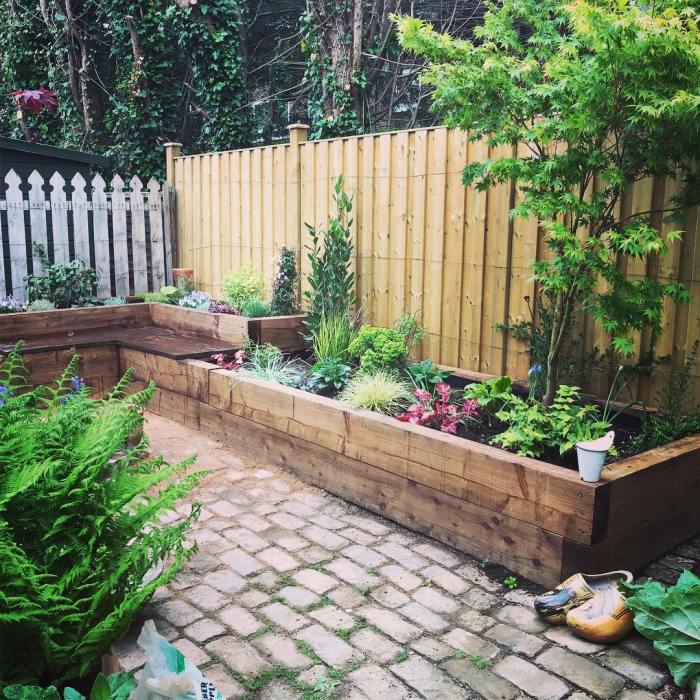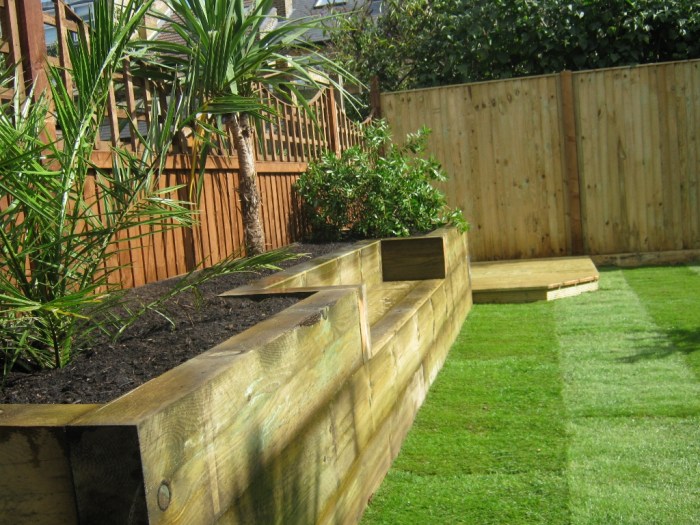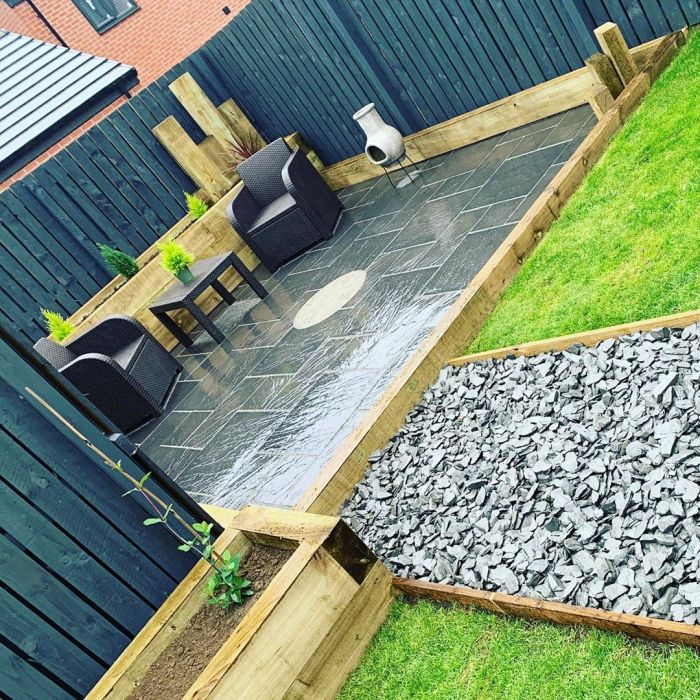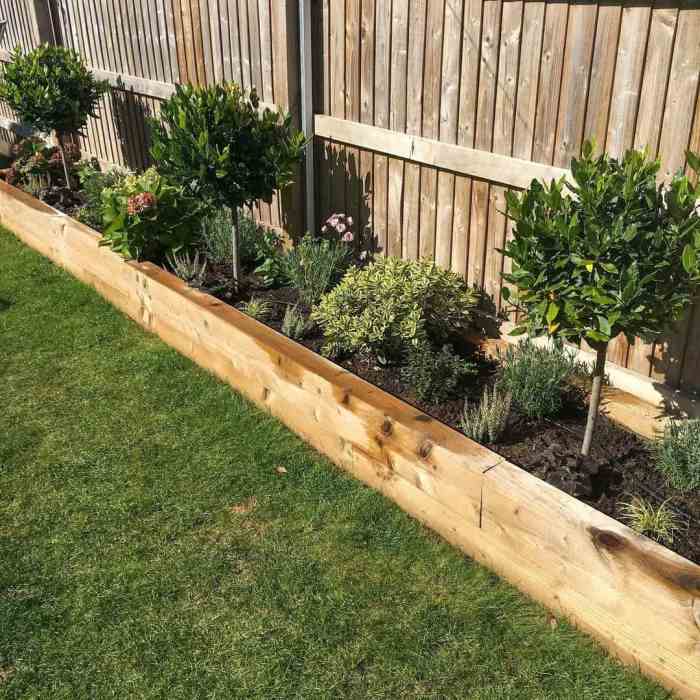Embark on a journey of horticultural inspiration with railway sleeper garden ideas, where the rugged charm of these reclaimed materials meets the boundless possibilities of garden design. From raised beds to vertical gardens, borders to seating areas, railway sleepers offer a versatile and enduring foundation for creating captivating outdoor spaces.
Whether you envision a formal garden with crisp lines and geometric shapes or a whimsical wonderland bursting with vibrant colors and textures, railway sleepers provide a sturdy and adaptable canvas to bring your dreams to life.
Types of Railway Sleepers for Garden Use

Railway sleepers, also known as railroad ties, are versatile materials that can add a unique touch to your garden. They come in various materials, each with its own advantages and disadvantages.
The most common types of railway sleepers for garden use include hardwood, softwood, concrete, and plastic.
Hardwood Railway Sleepers
Hardwood railway sleepers are durable and long-lasting, making them a good choice for heavy-duty applications such as raised beds and retaining walls. They are also naturally resistant to rot and decay.
However, hardwood railway sleepers are more expensive than other types of sleepers and can be difficult to work with due to their weight and hardness.
Softwood Railway Sleepers
Softwood railway sleepers are less durable than hardwood sleepers, but they are also less expensive and easier to work with. They are a good choice for lightweight applications such as edging and borders.
However, softwood railway sleepers are more susceptible to rot and decay, so they may need to be treated with a preservative before use.
Concrete Railway Sleepers
Concrete railway sleepers are very durable and low-maintenance, making them a good choice for areas with heavy foot traffic or extreme weather conditions.
However, concrete railway sleepers are heavy and difficult to move, and they can be expensive to purchase.
Plastic Railway Sleepers
Plastic railway sleepers are lightweight and easy to work with, and they are resistant to rot and decay. They are also available in a variety of colors, so you can find a style that matches your garden décor.
However, plastic railway sleepers can be more expensive than other types of sleepers, and they may not be as durable in extreme weather conditions.
Design Ideas for Railway Sleeper Gardens
Railway sleepers, with their unique blend of durability and rustic charm, offer endless possibilities for creating stunning garden designs. From raised beds to borders and pathways, these versatile elements can transform your outdoor space into a haven of greenery and style.
The design possibilities with railway sleepers are vast, allowing you to tailor your garden to suit any style or preference. Whether you favor formal elegance, informal charm, modern simplicity, or rustic allure, railway sleepers can be effortlessly incorporated to create a cohesive and visually appealing outdoor sanctuary.
Raised Beds
Railway sleepers excel as raised beds, providing excellent drainage and aeration for your plants. They are particularly beneficial for vegetables and herbs, as they keep the soil warm and well-drained, promoting healthy growth and bountiful harvests.
- Formal Style:Create symmetrical raised beds with clean lines and sharp edges, using sleepers of uniform height and width. Enhance the formality with gravel paths or box hedging.
- Informal Style:Opt for sleepers of varying heights and widths to create a more relaxed and naturalistic look. Incorporate curves and irregular shapes to mimic the organic flow of nature.
- Modern Style:Design raised beds with a contemporary aesthetic, using sleek lines and geometric shapes. Paint the sleepers in bold colors or add metallic accents for a touch of urban chic.
- Rustic Style:Embrace the rugged charm of railway sleepers by leaving them untreated or staining them in natural tones. Create raised beds with a weathered, timeworn appearance that blends seamlessly with a cottage garden or woodland setting.
Plant Selection for Railway Sleeper Gardens
Railway sleeper gardens offer a unique environment for plants, with well-drained soil and ample sunlight. To ensure your garden thrives, carefully select plants that can withstand these conditions.
Consider the following factors when choosing plants:
- Soil type:Railway sleeper gardens typically have well-drained, sandy soil.
- Drainage:The raised nature of railway sleeper gardens ensures good drainage, so plants that tolerate dry conditions are ideal.
- Sunlight:Most railway sleeper gardens receive full sun, so choose plants that can thrive in these conditions.
Plant Recommendations
Some recommended plants for railway sleeper gardens include:
- Succulents:These plants are drought-tolerant and can thrive in the well-drained soil of railway sleeper gardens.
- Herbs:Many herbs, such as rosemary, thyme, and lavender, are well-suited to the conditions in railway sleeper gardens.
- Drought-tolerant flowers:Flowers such as zinnias, marigolds, and daisies can withstand the dry conditions of railway sleeper gardens.
- Vegetables:Some vegetables, such as tomatoes, peppers, and zucchini, can be successfully grown in railway sleeper gardens if they are watered regularly.
Vertical Gardening with Railway Sleepers: Railway Sleeper Garden Ideas

Vertical gardening with railway sleepers is an innovative way to create a unique and space-saving garden. By stacking railway sleepers vertically, you can create a raised bed that is perfect for growing flowers, herbs, and vegetables.
To build a vertical railway sleeper garden, you will need the following materials:
- Railway sleepers
- Drill
- Screws
- Soil
- Plants
Once you have gathered your materials, you can begin building your vertical garden.
Step 1: Prepare the Railway Sleepers
The first step is to prepare the railway sleepers. You will need to drill holes into the sleepers so that you can screw them together. The holes should be spaced evenly apart, and they should be deep enough to accommodate the screws.
Step 2: Assemble the Vertical Garden, Railway sleeper garden ideas
Once the railway sleepers are prepared, you can begin assembling the vertical garden. Start by stacking the sleepers on top of each other, and then screwing them together. You can create a garden of any size or shape that you want.
Step 3: Fill the Vertical Garden with Soil
Once the vertical garden is assembled, you can fill it with soil. Use a potting mix that is specifically designed for raised beds.
Step 4: Plant the Vertical Garden
The final step is to plant the vertical garden. You can plant any type of flower, herb, or vegetable that you want. Be sure to choose plants that are appropriate for the amount of sunlight that your garden will receive.
Creating Edgings and Borders with Railway Sleepers
Railway sleepers can add a touch of rustic charm to your garden while also serving a practical purpose. They can be used to create decorative edgings and borders that define the boundaries of your flower beds, paths, or other garden features.
There are several different ways to use railway sleepers for edging. One popular method is to sink them into the ground vertically, creating a raised border. This is a good option for raised flower beds or to create a level edge for a path.
Laying Railway Sleepers Horizontally
Another option is to lay the railway sleepers horizontally, either flush with the ground or slightly raised. This creates a more subtle border that is still effective at defining the edge of your garden features.
Using Railway Sleepers to Create Curves
Railway sleepers can also be used to create curved edges. To do this, simply cut the sleepers to the desired length and shape and then fit them together using bolts or screws.
Using Railway Sleepers as Retaining Walls
Railway sleepers can be an effective and durable solution for retaining walls in garden settings. They provide a sturdy and long-lasting structure that can withstand the pressure of soil and other materials.
Construction Considerations
When using railway sleepers as retaining walls, it is essential to consider several factors to ensure their stability and longevity:
Height and Length
The height and length of the retaining wall will determine the number of sleepers required and the depth of the foundation. Taller and longer walls will require more sleepers and a deeper foundation to provide adequate support.
Soil Conditions
The type of soil in which the retaining wall is being constructed will influence the foundation design. Well-drained soils require less extensive foundations compared to poorly drained soils, which may require additional drainage measures.
Drainage
Proper drainage is crucial to prevent water buildup behind the retaining wall, which can lead to instability and collapse. Drainage holes or weep holes should be incorporated into the wall to allow water to escape.
Foundation
A solid foundation is essential for the stability of the retaining wall. The foundation should be dug to a depth below the frost line and wide enough to provide adequate support for the sleepers.
Backfill Material
The material used to backfill behind the retaining wall should be well-compacted and free of large rocks or debris. Compacting the backfill ensures proper support for the wall and prevents settlement.
Creating Seating Areas with Railway Sleepers
Railway sleepers, with their inherent durability and rustic charm, offer a unique opportunity to create functional and visually appealing seating areas in your garden. From benches to chairs and tables, the possibilities are endless.
Building Railway Sleeper Benches
Constructing a railway sleeper bench is relatively straightforward. Begin by laying out the desired number of sleepers side-by-side, ensuring they are level and evenly spaced. Secure them together using galvanized bolts or screws, ensuring a sturdy base. For added comfort, consider adding a layer of cushioning or outdoor fabric to the top surface.
Railway Sleeper Chairs
For a more personalized touch, create railway sleeper chairs by attaching a backrest and armrests to a single sleeper. Use bolts or screws to secure the components, and consider adding a seat cushion for enhanced comfort.
Railway Sleeper Tables
To create a railway sleeper table, arrange several sleepers in a square or rectangular shape, securing them together as before. Place a sturdy tabletop made of wood, metal, or even glass on top, and secure it using bolts or screws.
For added stability, consider adding cross braces underneath the tabletop.
Lighting for Railway Sleeper Gardens

Illuminating railway sleeper gardens plays a pivotal role in enhancing their aesthetic appeal and extending their usability beyond daylight hours. Strategic lighting can create a captivating ambiance, highlighting design elements and guiding visitors through the space.
By incorporating lighting into your railway sleeper garden, you can:
- Enhance the aesthetics of your garden by highlighting architectural features and creating dramatic shadows.
- Improve functionality by providing visibility and safety during evening hours.
- Create a welcoming and inviting atmosphere for gatherings and relaxation.
Types of Lighting
There are various types of lighting suitable for railway sleeper gardens, each serving a specific purpose:
- Uplighting:Illuminates vertical surfaces, such as walls or sleepers, from the ground up, creating a dramatic effect.
- Downlighting:Projects light from above, highlighting specific areas or plants, and reducing glare.
- Spotlighting:Focuses light on particular objects or features, creating focal points.
- Path lighting:Provides illumination for walkways and paths, ensuring safe navigation.
- Mood lighting:Creates a subtle and atmospheric glow, enhancing the ambiance of the garden.
Maintenance and Care of Railway Sleeper Gardens

Maintaining railway sleeper gardens is crucial for their longevity and aesthetic appeal. Here are some tips to keep them in top condition:
- Regular Cleaning:Remove dirt, debris, and weeds regularly to prevent rot and maintain a clean appearance.
- Periodic Inspections:Inspect sleepers for signs of decay, cracks, or damage. Replace or repair any damaged sleepers promptly.
- Protection from Moisture:Protect sleepers from excessive moisture by ensuring proper drainage and applying a sealant or water repellent.
- Pest Control:Treat sleepers with appropriate insecticides or pesticides to prevent infestation by insects or pests.
- Fertilization:Fertilize plants in the garden regularly to ensure healthy growth and vitality.
Common Issues and Solutions
Decay:Replace decayed sleepers immediately and improve drainage to prevent further issues. Cracks:Repair small cracks with epoxy or wood filler. For larger cracks, consider replacing the sleeper. Weeds:Remove weeds regularly and apply weed barriers or herbicides to prevent their growth. Insect Infestation:Treat sleepers with appropriate insecticides or pesticides and remove any affected plants or debris.
Excessive Moisture:Improve drainage by creating slopes or installing drainage systems. Apply a sealant or water repellent to protect sleepers from moisture.
Last Recap
As you delve into the world of railway sleeper garden ideas, remember that the true beauty lies in the interplay of materials, plants, and design. Experiment with different combinations and let your creativity flourish. With a little planning and effort, your railway sleeper garden will become a sanctuary where nature and imagination intertwine.
FAQ Explained
What types of plants thrive in railway sleeper gardens?
Railway sleeper gardens provide unique conditions, so it’s best to choose plants that tolerate well-drained soil and occasional moisture retention. Consider succulents, drought-tolerant herbs, and flowers like lavender, rosemary, and geraniums.
How do I maintain a railway sleeper garden?
Regular maintenance is key. Inspect sleepers for rot or damage, clean them with a pressure washer or stiff brush, and apply a protective sealant to extend their lifespan. Replenish soil and mulch as needed, and control weeds promptly.
Can I use railway sleepers to create raised beds?
Absolutely! Railway sleepers are an excellent choice for raised beds. Their durability and natural resistance to rot make them ideal for containing soil and supporting plants. Simply stack the sleepers to the desired height and fill with soil.


